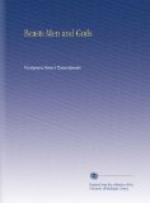“The Chinese merchants are heading for the west and we must travel south.”
“No! To the north,” I replied very sharply.
“But no, to the south,” my companions assured me.
“God and the Devil!” I angrily ejaculated, “we have just swum the Little Yenisei and Algyak is to the north!”
“We are in Tibet,” remonstrated my companions. “We must reach the Brahmaputra.”
Brahmaputra. . . . Brahmaputra. . . . This word revolved in my fiery brain, made a terrible noise and commotion. Suddenly I remembered everything and opened my eyes. I hardly moved my lips and soon I again lost consciousness. My companions brought me to the monastery of Sharkhe, where the Lama doctor quickly brought me round with a solution of fatil or Chinese ginseng. In discussing our plans he expressed grave doubt as to whether we would get through Tibet but he did not wish to explain to me the reason for his doubts.
CHAPTER XVI
IN MYSTERIOUS TIBET
A fairly broad road led out from Sharkhe through the mountains and on the fifth day of our two weeks’ march to the south from the monastery we emerged into the great bowl of the mountains in whose center lay the large lake of Koko Nor. If Finland deserves the ordinary title of the “Land of Ten Thousand Lakes,” the dominion of Koko Nor may certainly with justice be called the “Country of a Million Lakes.” We skirted this lake on the west between it and Doulan Kitt, zigzagging between the numerous swamps, lakes and small rivers, deep and miry. The water was not here covered with ice and only on the tops of the mountains did we feel the cold winds sharply. We rarely met the natives of the country and only with greatest difficulty did our Kalmuck learn the course of the road from the occasional shepherds we passed. From the eastern shore of the Lake of Tassoun we worked round to a monastery on the further side, where we stopped for a short rest. Besides ourselves there was also another group of guests in the holy place. These were Tibetans. Their behavior was very impertinent and they refused to speak with us. They were all armed, chiefly with the Russian military rifles and were draped with crossed bandoliers of cartridges with two or three pistols stowed beneath belts with more cartridges sticking out. They examined us very sharply and we readily realized that they were estimating our martial strength. After they had left on that same day I ordered our Kalmuck to inquire from the High Priest of the temple exactly who they were. For a long time the monk gave evasive answers but when I showed him the ring of Hutuktu Narabanchi and presented him with a large yellow hatyk, he became more communicative.
“Those are bad people,” he explained. “Have a care of them.”




